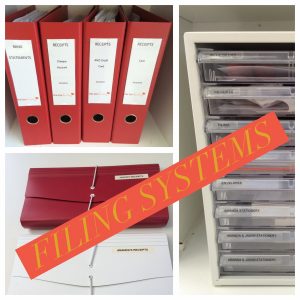There is nothing worse than having to gather all of your receipts up at tax time only to find you have misplaced some. Lost receipts = lost tax deductions and you will end up paying more tax (and maybe GST) than you should.
Here are a few of the systems that I have given my clients over the years and in fact they are the systems that I still use.
The secret to having good accounting and tax records is to decide on a system that works for you and then STICK to it ALL YEAR!

HAVE A MOBILE FILING SYSTEM & USE IT DAILY
A small expanding wallet is perfect http://www.officeworks.com.au/shop/officeworks/quill-urban-chic-expanding-wallet-red-qu287rd
This is great for keeping in the car and should be used instead of the car glovebox, console or floor!
It could also be carried around in your handbag and used instead of filing into your wallet.
I recommend that you label each of the sections for each type of expense eg. car expenses, office supplies, personal, medical.
HAVE A DESKTOP FILING SYSTEM & USE IT DAILY AND WEEKLY
A desktop set of filing drawers is perfect
This is great for filing receipts that have been emailed to you and you want to print out and file or to file bills as you pay them.
You can also use these trays to store invoices or bills as you receive them and then when you want to pay bills in a batch you just need to open the drawer as opposed to having to go searching in the kitchen, desk drawers, bedside table etc.
I recommend that you label each of the trays eg. bills to pay, bills paid from business account, bills paid from business credit card, bills paid personally or by cash, filing etc. This will make it easier for you to tick off against your bank statements each month or to summarise the expenses if you are using a manual system.
HAVE A LEVER ARCH FILING SYSTEM THAT EVERYTHING IS TRANSFERRED TO AT THE END OF THE MONTH
Good quality lever arch folders with a spine that can be easily labelled are perfect.
At the beginning of the year, insert month dividers – start with July and finish up with June.
I also like to keep a separate lever arch folder for the way I pay for the expense ie. RECEIPTS – business cheque account, RECEIPTS – credit card, RECEIPTS – cash, however if you are a small business and don’t have that many receipts or are short of space in your office, just use one folder for all receipts and then divide each month’s section with a coloured piece of paper of you would like to keep separate.
At the end of each month sit down with your bank statement(s). Start at the beginning of the statement, find the relevant receipt, tick off/highlight the amount on the bank statement and file. By filing in this order, it is easy to go back and find the invoice if you need it for warranty etc. For any amount not highlighted, go searching for the receipt or request another one from the supplier if possible. This practice will ensure that you have documentary evidence should you be subjected to an ATO audit and also that will be able to maximise your tax deductions at the end of the year.
I note that the system described above is a manual one and many business owners will prefer to use an electronic filing system. If this is the case you can use many of the record keeping apps on the market, however it is still good practice to have some sort of end of month process that you compare your electronic copy of receipts to the bank statement.
I hope this has given you some inspiration and motivation to start the 2014/2015 with a great record keeping system.
